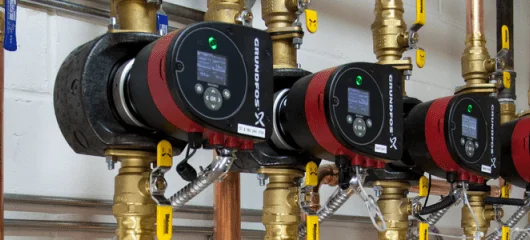Every hydronic system is different, so there is no absolute correct answer when it comes to how often a dirt separator should be "blown down", however, we can make some general recommendations.
For new, relatively clean installations (with all new piping and heat emitters), you should be able to run the system for a week or two before an initial blow down. If the project is a retrofit, however, and has a lot of existing piping and old heat emitters, do an initial blow down within a day or two and carefully examine what comes out. If the system appears to be extremely dirty, repeat blow downs every few days, initially, to remove as much dirt as possible to protect any new equipment.
On smaller systems, purging a quart or two of fluid should be enough to completely clean out the separator. On larger systems, purging a few gallons should do it. Observe the fluid coming out; when it runs clear you can close the blow down valve. It's a good idea to collect the dirt in a white bucket and let it settle for a few minutes, then check it carefully. It is common to see solder balls, metal shavings, flux goobers, sand, dust, etc. A reddish/brown material is likely iron oxide (rust), a product of corrosion.
If you are using a magnetic dirt separator, such as the Caleffi DIRTMAG or DISCALDIRTMAG, you may also find magnetite, a highly magnetic and abrasive mineral, black in color. Magnetite laden water can appear gray, until it settles out, and is especially damaging to wetted moving parts such as pump and valve seals. It also builds up on heat exchangers which drastically reduces heat transfer efficiency and life expectancy.
Observe the water quality each time you do a blow down. When the fluid starts looking cleaner with each blow down, sample frequency can be reduced, eventually to 3 or 4 times per year. Again, every job is different and the maintenance staff can get a feel for how often it should be done. Systems with ongoing corrosion and dirt problems may require more frequent blow downs.
Regarding procedure, shutting down the pumps prior to blow down it not required, but, when the pumps are not running you can be sure all of the collected dirt in the separator will be purged and none will be carried through the separator by flowing water. If you have a magnetic dirt separator, remove the magnet before opening the purge valve. This will release any of the captured magnetic material so it can be purged. After closing the purge valve, simply re-attach the magnet.
One more thing, be sure the system fill valve is not isolated so the loss of pressure in the system (due to purging) will be made up. Click on the video link below; it's a very large retrofit project which, as the contractor discovered, had a BIG problem with magnetite!







Question about water quality.
Does it not seem awkward to take "contaminated" water and condition it by removing most but not all of the ions?
Would it not be better to start with pure distilled water and add exactly the required amount and type of beneficial ions?
Thanks.
Yes, some contractors start with distilled water and add glycol, or a boiler water treatment product. Not sure how you would add "beneficial" ions. The HYDROFILL demineralizer simplifies, and reduces the cost of, the process of filling a hydronic system because it uses whatever "contaminated" free site water is available. That way, you don't have to purchase and then transport special fill water to the site.
Hello Kevin/Caleffi. I have just ordered two of the Magnetic Dirt Separators for my hydronic system (using an outdoor wood boiler (OWB) to heat two buildings and so am filtering both sides). Really appreciate your Q&A section.
Couple of questions for you:
1) I have a Ground Source Heat Pump system in my house that is water to water to air. I am tapping into that with my new OWB and in doing so I discovered corrosion and scale build up. It appears the system is still salvageable but its condition has me wondering what I can do to ensure the water I use going forward is the best I can reasonably get it. I am on well water. I have a Kinetico water softener preceded with 5 micron sediment filters. Should I use this softened water? Should I purchase an RO system to further clear the water of minerals? Total system volume is approximately 100 gallons. Any other suggestions?
2) My existing system had a micro bubble air separator that had an expansion tank connected below it. I discovered that the bottom of the air separator was plugged with sludge and as a result the expansion tank was ineffective. I am speculating that the loss of expansion management resulted in the system having air drawn into the system when the hydronic water cooled in the off season (drawing air in through the air separator instead of just pushing it out) and as a result increased the corrosion I found. I am guessing that if I place a magnetic dirt filter in front of the replacement micro bubble air separator (the internal mesh was corroded in the original and in my ignorance I broke the float mechanism disassembling it) that the air separator is less likely to become plugged in future but should I have the expansion tank mounted separately from these devices? Is there a reason that most of these tanks are mounted hanging down rather than above the pipe? My brand confirms that either is fine but I am wondering if there are other considerations? The circulation pump draws through these components (in case you were wondering). Any other related thoughts would be appreciated.
Thanks
Richard
Richard,
Thanks for your comments and questions!
1. Softened water does remove the potential for scaling but it does increase the potential for galvanic corrosion with the salts that are added (replacing magnesium and calcium). For closed loop systems, RO or demineralized water is your best bet along with a quality inhibitor. At this point I would recommend isolating the system from the water supply in your home to prevent any of your water supply from entering the system in the case of a leak. This will only be a viable option if it is a closed system where you're not continually adding fresh water. If your wood boiler is open and you're having to add water on a regular basis I would highly recommend isolating the wood boiler from the rest of the components using a plate heat exchanger. This does add complexity but it certainly isolates a lot of the dirty water problems to the wood boiler, piping and heat exchanger and keeps it out of the rest of your system.
2. Any dirt separation device should be on the common return before the appliance and pumps whereas air separators are most effective between the heat source and the pump. By placing the dirt separator upstream of the air separator this would make your expansion tank placement no problem. I would also recommend a good flush of the system using high velocity flow.
Best Regards,
Cody Mack
Applications Engineer
Caleffi North America
414-238-2360
Upon opening the valve to remove the dirt, than, were does the make up water comes from ? ?,
When doing a dirt separator blowdown, the fill valve/PRV must be open to provide makeup water.